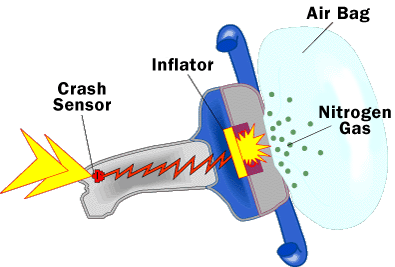 1. For years, the trusty seat belt provided the sole form of passive restraint in our cars. There were debates about their safety, especially relating to children, but over time, much of the country adopted mandatory seat-belt laws. Statistics have shown that the use of seatbelts has saved thousands of lives that might have been lost in collisions.
1. For years, the trusty seat belt provided the sole form of passive restraint in our cars. There were debates about their safety, especially relating to children, but over time, much of the country adopted mandatory seat-belt laws. Statistics have shown that the use of seatbelts has saved thousands of lives that might have been lost in collisions.2. How about an airbags? What an airbag wants to do is to slow the passenger's speed to zero with little or no damage. The constraints that it has to work within are huge. The airbag has the space between the passenger and the steering wheel or dashboard and a fraction of a second to work with. Even that tiny amount of space and time is valuable, however, if the system can slow the passenger evenly rather than forcing an abrupt halt to his or her motion.
3. The goal of an airbag is to slow the passenger's forward motion as evenly as possible in a fraction of a second. There are three parts to an airbag that help to accomplish this feat:
4. The bag itself is made of a thin, nylon fabric, which is folded into the steering wheel or dashboard or, more recently, the seat or door.
 5. The sensor is the device that tells the bag to inflate. Inflation happens when there is a collision force equal to running into a brick wall at 10 to 15 miles per hour (16 to 24 km per hour) or in other delta V. A mechanical switch is flipped when there is a mass shift that closes an electrical contact, telling the sensors that a crash has occurred. The sensors receive information from an accelerometer built into a microchip.
5. The sensor is the device that tells the bag to inflate. Inflation happens when there is a collision force equal to running into a brick wall at 10 to 15 miles per hour (16 to 24 km per hour) or in other delta V. A mechanical switch is flipped when there is a mass shift that closes an electrical contact, telling the sensors that a crash has occurred. The sensors receive information from an accelerometer built into a microchip. 6. The airbag's inflation system reacts sodium azide (NaN3) with potassium nitrate (KNO3) to produce nitrogen gas. Hot blasts of the nitrogen inflate the airbag.
6. The airbag's inflation system reacts sodium azide (NaN3) with potassium nitrate (KNO3) to produce nitrogen gas. Hot blasts of the nitrogen inflate the airbag.7. So this is basic idea you need to know. I'll post more about airbag, the consequence of airbag during the crash.
No comments:
Post a Comment